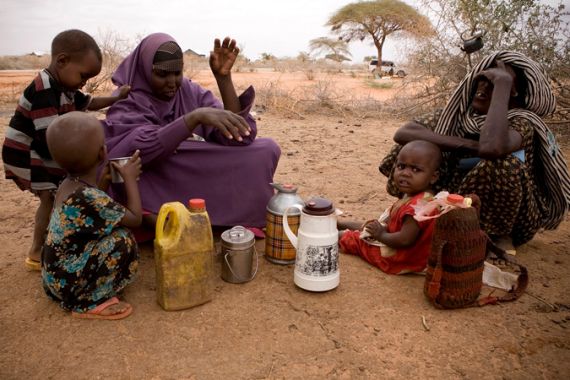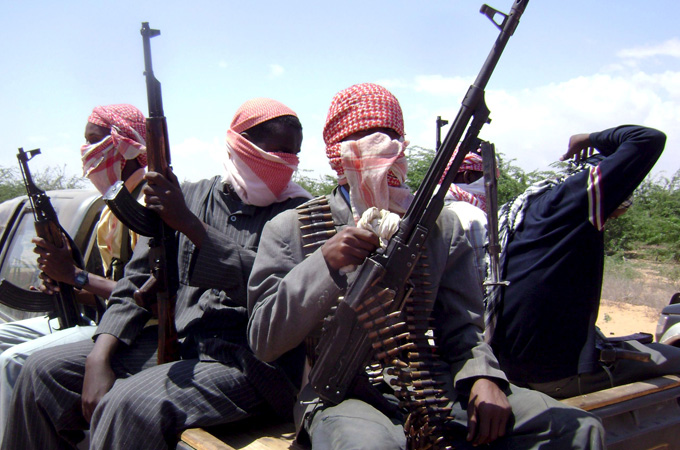Genocidal politics and the Somali famine
The blame for Somalia’s devastating famine should not be levelled at the weather, but at geopolitics and armed militia.

 |
| Somali militia, as well as other armed forces active in the region, have played a major role in creating the conditions for the current famine in Somalia [EPA] |
Droughts are common in the Somali peninsula, but only an exceptional one produces famine. For instance, the Horn of Africa drought of 1984 did not produce famine in Somalia, while the Ethiopian population was devastated. The latter country suffered famine because the military government of the time was engaged in a civil war, and did not come to the rescue of its people.
Ten years earlier, in the mid-1970s, there was a prolonged drought, known as “dabadeer” [“the long-tailed”], in several parts of Somalia. Fortunately, this drought did not lead to mass starvation because the Somali government moved quickly to assist the people. They mobilised the population and sought the assistance of international allies to deliver food and water to the needy.
Keep reading
list of 4 items‘Mama we’re dying’: Only able to hear her kids in Gaza in their final days
Europe pledges to boost aid to Sudan on unwelcome war anniversary
Birth, death, escape: Three women’s struggle through Sudan’s war
Somalia’s last major famine was in 1992 and was not caused by drought. Nearly 300,000 innocent people starved to death because of sectarian politics. The epicentre of that famine was in Bay, one of the country’s most productive agricultural regions, and starvation was induced by warlords who used food as a weapon against farmers and pastoralists.
Marauding gangs had invaded the region after the collapse of the Somali state in 1991 and looted farmers’ harvests. The country’s major warlord wanted to capture the region, so did not allow food aid to reach the desperate population. Reports told of unimaginable suffering long before TV images of ruined lives reached millions around the world. It was only then that US president George HW Bush decided to send US troops to the country to enable food to reach the indigent population.
The climatic record show that droughts frequently occur in the Somali peninsula, but have not produced famines over the past fifty years, until 2011. However, the UN and other international actors have been arguing about the devastating drought in the area for nearly a year, while only a handful of scholars and activists were alarmed by the creeping famine. What thoughtful people must ask is: “Why famine now?”
Who is to blame?
 |
| Click here for further in-depth coverage |
The Somali people in the affected regions have been made vulnerable to ecological disturbances because of several political and military forces. These include the US “War on Terror”, the al-Shabaab terrorist group, Somalia’s Transitional Federal Government (TFG), the Ethiopian invasion of Somalia and its continuous political and military involvement there, and finally East Africa’s Intergovernmental Authority on Development (IGAD) and the UN.
These actors have created circumstances in which local food resources were exhausted and assistance from outside was denied or delayed until tens of thousands of people starved.
Exactly what role did each of these forces play in manufacturing the famine? First, the US agenda in Somalia has been to fight what it calls “Islamic terrorists”, and al-Shabaab in particular. Since the bombing of the US embassies in Kenya and Tanzania in 1998, and especially since 9/11, clandestine operations were conducted to snatch “terrorists” and dry up their support base in Somalia. These operations sought assistance from several of Mogadishu’s warlords, who formed the “Alliance for the Restoration of Peace and Counter-Terrorism” in 2005.
Somalis despised this alliance and their patron, and ultimately turned against them under the leadership of the Union of Islamic Courts (UIC) in 2006. The UIC defeated the warlords, restored peace to Mogadishu for the first time in 15 years, and brought most of southern Somalia under its ambit.
Consequently, the US and its Ethiopian ally claimed that these Islamists were terrorists and therefore a menace to the region. In contrast, the vast majority of Somalis supported the UIC and pleaded with the international community to engage them peacefully. But the peace did not last. The US-supported Ethiopian invasion begun in December 2006 and displaced more than a million people and killed close to 15,000 civilians. Those displaced then are part of today’s famine victims. Somalia counterattacked, and Ethiopia was compelled to withdraw the bulk of its troops from Somalia. But the dynamics generated by the Ethiopian invasion continue to destabilise the country.
Second, IGAD and the international community picked up where the Ethiopians left off, by designing a new TFG – led by the faction of the UICs most amenable to the international community, and particularly to the US agenda. The new regime marginalised the forces that compelled Ethiopia to withdraw from Somalia. Consequently, the TFG came to control only those areas in Mogadishu under the command of the African Union force.
A new civil war ensued between the TFG and its opponents, and within a month much of southern Somalia fell under the sway of al-Shabaab and its affiliates. Once in power, the TFG became known for its corruption, incompetence, and internal strife. Propped up by the international community, the regime in Mogadishu has been oblivious to the growing crisis, which ultimately led to the death of nearly 80,000 of its “citizens”. It has yet to articulate a plan of actions to rescue its population. Engulfed in an internal power struggle, the regime has failed to put aside sectarian politics to save the population.
Al-Shabaab fails to govern
|
The drought was declared a famine when “it was no longer possible to conceal the deaths of almost 80,000 people from starvation” |
Third, al-Shabaab – originally the youth wing of the UIC – declared its affiliation with al-Qaeda, and were identified as a terrorist group by the UN and the US, and have been consequently targeted by US forces. The UN and the US have blocked food shipment to the areas that al-Shabaab controls in order to deny them these supplies. Al-Shabaab wants to establish an Islamic state, but unfortunately, it has failed to put in place even the most rudimentary infrastructure to govern the region or provide services.
Furthermore, al-Shabaab has denied the population the opportunity to organise itself to meet the challenges of the livelihood crisis. Thus, despite the fact that the two epicentres (Lower Shabeele and Bakool) of the famine are in al-Shabaab hands, they have failed to appeal even to the Islamic world for assistance. Most insidiously, they continue to deny the existence of significant famine conditions in the area and have consequently reneged on the permission they recently gave to the world community to deliver food to the starving.
Normally, societies have three lines of defence against mass starvation: local capacity, national government and the international community. When a disaster hits a region, the first help comes from local administrations and the communities themselves. If events overwhelm the first responders, then the national government takes charge of operations; and when the crisis exceeds the wherewithal of the nation, international actors come to the rescue.
It is clear that all three levels of livelihood protections have failed in Somalia. Al-Shabaab has prohibited the local population from organising their municipal governments and charities to fend off the disaster. Similarly, Somalia’s national government, which is beholden to sectarian leadership and international patrons, has been oblivious to the emerging calamity, and has thwarted the international community from coming to its aid.
The African Union, the UN, the EU, and the US continued to describe the famine as a drought until July 18, when it was no longer possible to conceal the deaths of almost 80,000 people from starvation. The United States and its allies have been so obsessed with defeating al-Shabaab that they have ignored the fate of the millions of people who live in areas controlled by al-Shabaab.
Finally, callous uses of military and political power by all actors against poor people have produced a catastrophic famine. Altering the behaviour of the powerful would be tantamount to a revolution. But before such a transformation can be imagined, lives must be saved by immediately dropping food and water in villages and settlements in the region. Such urgent distribution of life’s necessities will keep people in their homes before a humane scheme of reconstruction could begin.
What is ultimately required is the establishment, by Somalis with the genuine assistance of others, of a national government that is accountable to the people. Such a government is the best defence against famine, as well as against terrorism.
Abdi Ismail Samatar is a professor of geography at the University of Minnesota and a research fellow at the University of Pretoria, South Africa.
The views expressed in this article are the author’s own and do not necessarily reflect Al Jazeera’s editorial policy.
